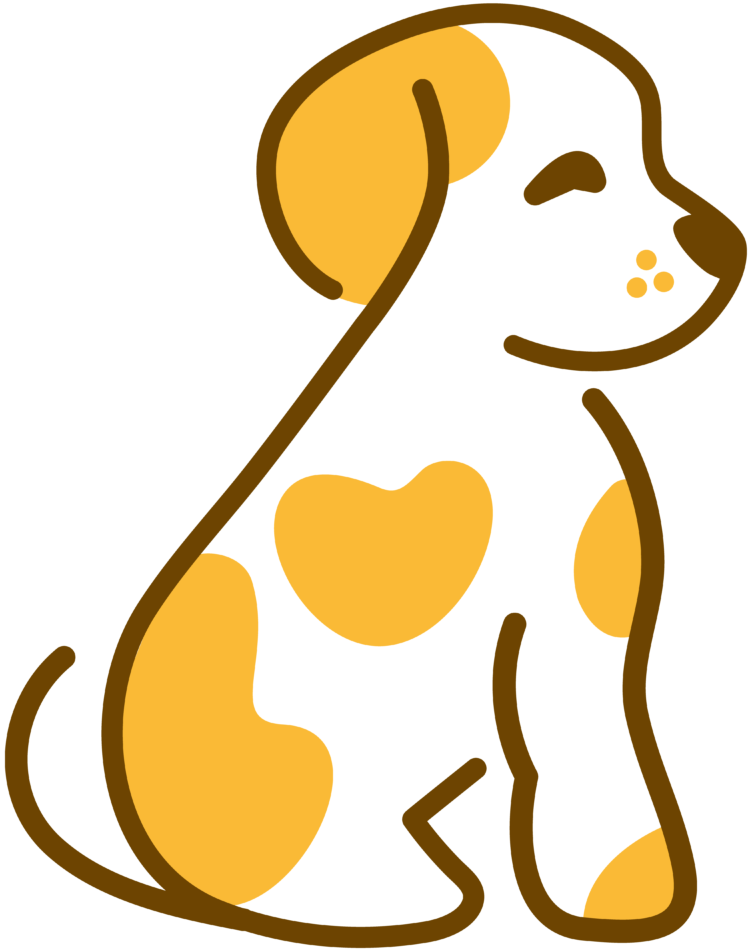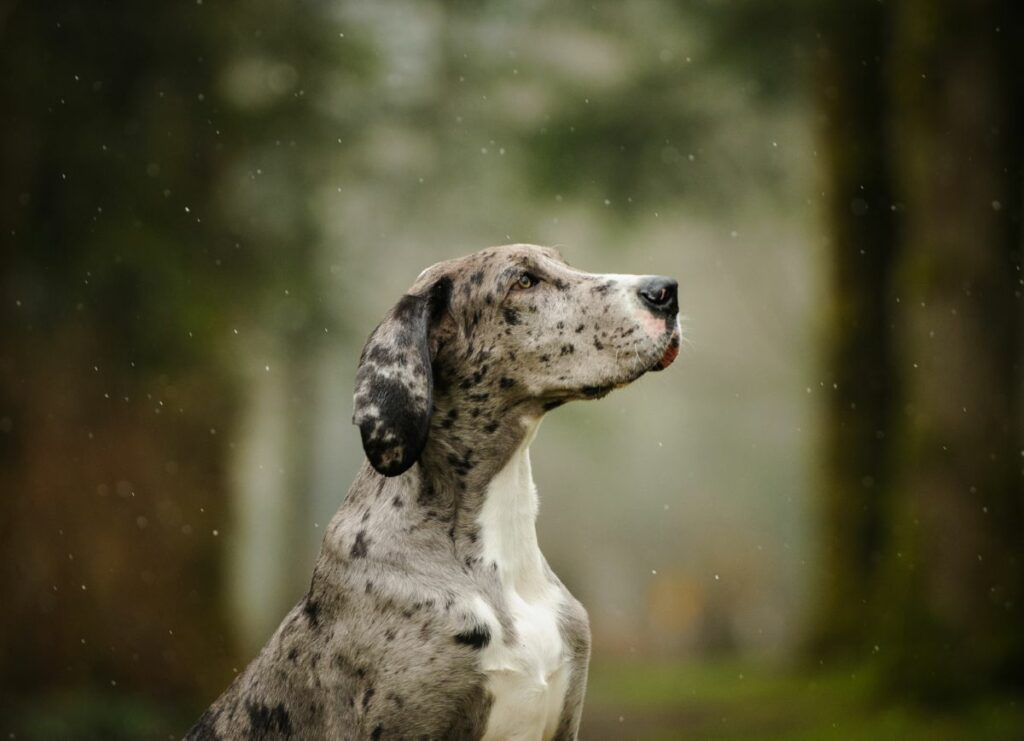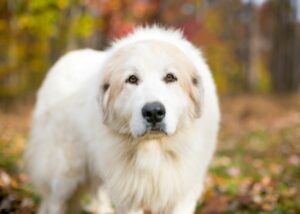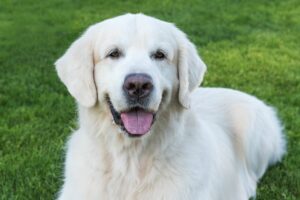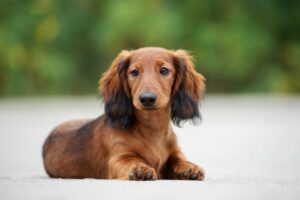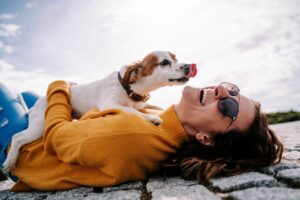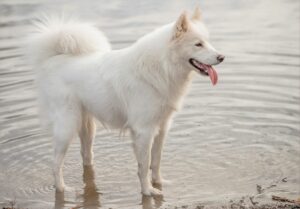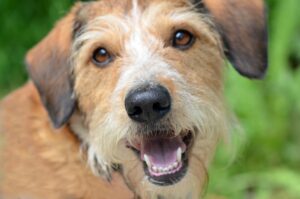The Great Dane originally comes from Germany, where it was used to hunt boars and bears. Today, the Great Dane is a beloved family dog. It is a big dog with a big heart. He is affectionate, loyal and friendly. It is a real family dog that sometimes even crawls on the lap of its owner. The Great Dane has a calm character, but needs a lot of exercise. He prefers to live in a house with a large, enclosed garden. The Great Dane is an elegant dog with a very fine character. Would you like to know more about the Great Dane? Then read on!
History: a hunting dog from Germany
The Great Dane originally comes from Germany. Crossbreeding Mastiff and Sight hounds created this dog breed. The English did this crossing around the 16th century. Hunting big game was one of the tasks of these dogs. Boars and bears were the target, but these animals were very large and strong. Therefore, they wanted to breed a stronger and more imposing hunting dog. At that time, the Germans were given a role in the breeding program and the Great Dane was born.
The Great Dane played an important role in big game hunting. This dog was strong enough to hunt large boars and bears. While hunting, the dogs were protected by a kind of shield around their bodies. This was to prevent injuries to their bodies.
Times changed and hunting the larger game became less and less popular. At that time, the Great Dane was considered a companion and guard dog for the princesses and noblemen. The Great Dane slept next to their bed to protect them from burglars.
The character: friendly, dedicated and confident
The Great Dane is a big dog with a big heart. It is a friendly and loving dog. He is loyal to his owner and is generally a quiet dog. A puppy is often shy, but as an adult dog the Great Dane is confident. It is a real watchdog that likes to protect his owner. So don’t be surprised if your Great Dane barks regularly. It is important that you unlearn excessive barking early on. The Great Dane is reserved towards strangers.
The Great Dane benefits from a calm owner who stands firmly in his shoes and raises him consistently, kindly and clearly. He does not like to be alone for a long time and prefers to be with his owner a lot. The Great Dane is affectionate and likes to sit on your lap despite his size.
The Great Dane gets along well with children. It is wise to calmly get the dog and the children used to each other. The same applies to other (domestic) animals. Towards strange dogs the Great Dane can sometimes react fiercely, this happens especially with males. To ensure that your Great Dane shows desired behavior, a good socialization is very important.
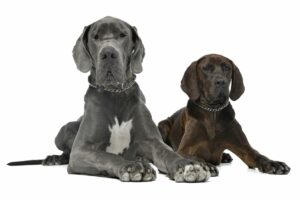
The appearance of a Great Dane
The Great Dane is a large-sized dog and is even one of the largest dog breeds in the world. He has an imposing and powerful body. A male Great Dane has a height at the withers between 76 and 86 centimeters and weighs between 54 and 90 kilograms. A female has a height at the withers between 71 and 81 centimeters and weighs between 45 and 59 kilos. A pet of size so.
The coat of the Great Dane is short, thick and smooth. A healthy coat looks shiny. The coat comes in different colors and color combinations, namely:
- Brindle: a yellow gold base color with black, brindle stripes.
- Fawn: yellow gold
- Blue: a pure steel blue color
- Black: full, glossy black
- Harlequin: a white base color with black spots.
- Cloak: black and white, where a kind of black cloak lies over the dog
- Merle: a light gray to dark gray base color with black spots
The Great Dane is large, elegant and strongly built. He is as tall as he is long. The chest is deep and his back is short and straight. The tail is usually set high. The legs are straight and strong and the feet are round. The head is long, narrow and has distinct facial features. The muzzle is deep and it has drooping upper lips and muscular cheeks. The eyes are almond-shaped and dark in color. The ears are set high and hang down. In summary, the Great Dane has a distinctive and powerful appearance.
The care
The Great Dane has a short coat that requires little special care. It is sufficient to brush him briefly every week with a soft brush or to remove the loose hairs with a damp cloth. Twice a year the Great Dane loses a little more hair. This period is also called the molt. During this period, it is wise to brush the dog daily. A Great Dane needs to be bathed only very occasionally. It is advisable to do this only if he has landed in something dirty.
Besides brushing, it is important to clean the ears and eyes weekly. The nails should also be trimmed regularly. It is wise to get the Great Dane used to grooming rituals from a young age. This will make grooming a lot easier when the dog is an adult.
Because stomach problems are the number one cause of death in this breed, it is essential to give the Great Dane high quality food. Educate yourself on which foods are appropriate for a dog and which are not. Feed your dog several small meals a day, as eating too much can lead to a bloated stomach in dogs. A bloated stomach is dangerous for dogs. In addition, a Great Dane should not run or play for the first two hours after eating.
This can cause gastric torsion. It is important that he first digests his food before he starts exercising intensively. The right food and a good diet can therefore significantly improve the health of the dog. You can ask your veterinarian for advice on what kind of food is suitable for your dog.

Are there any diseases that occur in this breed?
A Great Dane becomes on average between 8 and 10 years old. There are several hereditary diseases and disorders that can occur in this breed of dog. The Great Dane has an increased risk of the following health problems.
- Elbow and hip dysplasia.
- Stomach disorders
- Cancer
- Heart and muscle diseases
Because of its size, the Great Dane has a high risk of elbow and hip dysplasia. In this condition, the head and socket of the joint no longer fit together properly, causing wear and tear on the joints. Symptoms the dog may exhibit include lameness, stiffness, and difficulty getting up and moving. This condition may be hereditary, or it may not develop until later in life.
A Great Dane may suffer from gastric torsion. This condition is especially common in large dog breeds with a deep chest. The stomach may tilt and turn on its axis, causing the entrance and exit of the stomach to close and blood vessels to constrict. Gastric gases can no longer be expelled and the stomach becomes bloated. It is important to intervene quickly when this happens. Indeed, stomach torsion can be life-threatening for a Great Dane.
Cancer and tumors can also occur in the Great Dane. What especially often occurs in this breed is a bone tumor. This can occur at any place in the skeleton, but in the Great Dane it grows mainly in the front legs. The dog then suffers a lot of pain and lameness. This condition also occurs mainly in large dog breeds.
This breed can suffer from heart and muscle disease. Symptoms of heart disease are shortness of breath and reduced stamina. In this, the heart muscle can no longer contract properly. This can get progressively worse. It is therefore important to stay alert. To detect any muscle diseases you should always keep a close eye on how your dog moves. If in doubt, you can always ask the vet for advice.
Dog training for this breed
The Great Dane is a large dog and therefore it is important that you let him know who is the boss. He benefits from a friendly, but consistent and clear upbringing. It is wise to act friendly, because otherwise the Great Dane can react fiercely or unruly. From an early age you should teach this dog not to pull while walking. When the dog is an adult and he pulls on the leash, it is impossible to keep him with you. He is simply too big and too strong. A good socialization of a puppy is important to ensure that your dog shows desired behavior when he is an adult.
The Great Dane does not learn very quickly, but is still reasonably intelligent. It is important to ensure sufficient variety of exercises so that he does not get bored. In addition, provide sufficient physical and mental challenge.
For every dog it is important to follow a basic course or puppy training. This ensures a correct and early socialization of the dog. You will build a better bond with your dog and he will learn to listen to you. The dog will also get to know other dogs.
What does a Great Dane cost?
For a Great Dane with a normal pedigree you pay on average between $1200 and $1300. For a dog with an extended pedigree you will pay more money. It is advisable to buy the dog from an authorized breeder. An authorized breeder follows the rules and is aware of any hereditary diseases. If you visit a breeder, you can also see the mother dog and observe her behavior. Part of the behavior will, in fact, also be transferred to the puppy.
In addition to the purchase costs, you must also consider the maintenance costs. A basket, leash, food bowl and toys are products that you have to buy once when you take a dog into your home. There are also recurring costs such as food, dog tax, the vet and dog training. The Great Dane is a large dog and therefore needs a relatively large amount of food. On average you will pay $90 per month for food.
Before you buy a dog, you should check if you can afford these costs. Only buy a dog if you can afford these costs. Every dog deserves an owner who can take good care of him.

How much exercise does this breed need?
The Great Dane is a large dog that needs a lot of exercise to expend its energy. Because of its size, this dog breed is not suitable for people who live in a small apartment. A Great Dane feels most comfortable in a large house with a fenced yard or on a farm. If you don’t have a large yard, it’s important to make sure the Great Dane gets plenty of exercise in some other way.
Give a Great Dane the time and space to run loose. The normal walking pace is for this breed of dog quickly too slow. If you let the dog run loose, it is important that he is well behaved and does not bother other dogs or people. You must also ensure that he cannot run away.
Given its size, the Great Dane has an increased chance of developing joint problems. Therefore, it is important to build up the exercise slowly during the first two years and not let him do intensive movements, such as jumping. Also running on a slippery floor is not recommended. When the Great Dane is fully-grown, then you can let him run alongside the bike and go for long walks together.
In addition to the physical exercise, it is also wise to provide the dog with sufficient mental challenge. Think of tracking games or obedience training.
Recognition in the Netherlands
The AKC officially recognized the Great Dane as a breed in 1887. This means that it is a healthy dog breed that may be bred with and can participate in various sporting events. Also active in the US is the breed association the Great Dane Club Of America. They ensure that the Great Dane is bred and treated correctly. They organize various events, such as shows. In addition, you can contact this club if you are looking for a puppy.
Do you already own a Great Dane or are you planning on getting one?
It is a challenge to raise a Great Dane. But if you raise and socialize the dog correctly, you will have a buddy for eight to ten years. It is a friendly and loyal dog. He is looking for a quiet owner who wants to do activities with him. With proper socialization, the Great Dane gets along well with children and other pets. It is a large dog, so keep in mind that you will spend quite some money on maintenance. Do you have a Great Dane or are you up to the challenge and planning on getting one? Then leave a comment below this article!
